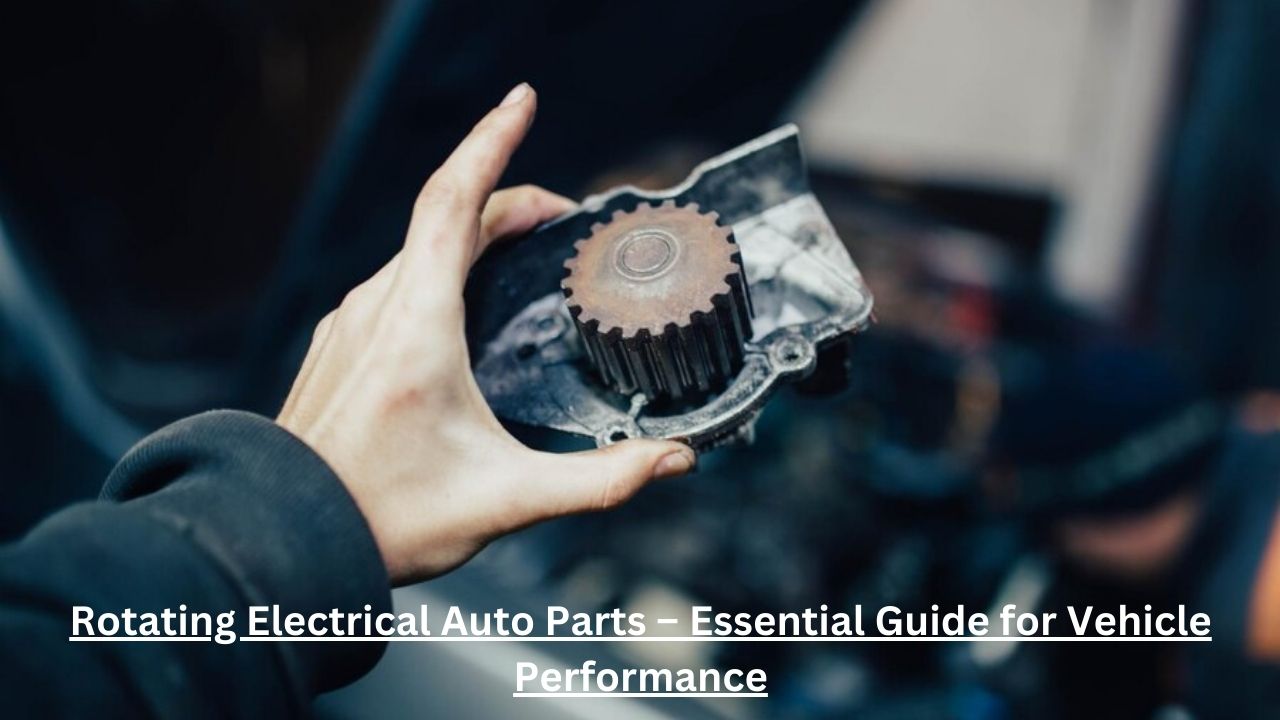Introduction to Rotating Electrical Auto Parts
Rotating electrical auto parts play a critical role in a vehicle’s operation. These components generate, distribute, and regulate electrical power while ensuring the engine runs efficiently. Every modern car depends on these essential parts for smooth performance.
Alternators, starters, and electric motors fall into this category. They keep your battery charged, help start your engine, and power different vehicle systems. Regular maintenance extends their lifespan and prevents unexpected failures on the road. Ignoring faulty components may lead to costly repairs or breakdowns.
Understanding these parts helps drivers diagnose problems early. You save money, avoid unnecessary replacements, and ensure reliable vehicle performance. Let’s break down the most important rotating electrical components and their functions.
Key Rotating Electrical Auto Parts and Their Functions
Alternator – Powering Your Vehicle’s Electrical System
The alternator generates electricity and keeps the battery charged. It powers essential components like lights, radio, and climate control systems. When the alternator fails, your car may stall, and the battery will drain quickly.
Common Alternator Problems:
- Dimming or flickering headlights indicate charging issues.
- A dead battery suggests an alternator failure.
- Strange noises like grinding or whining may signal worn-out bearings.
- Dashboard warning lights, such as the battery icon, may turn on.
Maintenance Tip: Regularly check the alternator belt for wear. A loose or broken belt affects charging efficiency.
Starter Motor – Getting the Engine Running
The starter motor cranks the engine when you turn the ignition key. It works with the battery and solenoid to start the combustion process. A failing starter leads to ignition problems and frustrating no-start situations.
Signs of a Bad Starter:
- Clicking sounds when turning the key.
- Slow or labored engine cranking.
- Frequent jump-starting needs.
- Smoke or burning smells near the starter.
Maintenance Tip: Keep battery terminals clean and check connections. Weak electrical flow reduces the starter’s efficiency.
Electric Motors – Powering Auxiliary Functions
Electric motors control various vehicle features, such as power windows, windshield wipers, and seat adjustments. These motors convert electrical energy into mechanical motion.
Common Issues with Electric Motors:
- Slow-moving power windows may indicate a weak motor.
- Wipers stopping mid-swipe could be due to motor failure.
- Unresponsive power seats may mean a faulty electrical connection.
Maintenance Tip: Lubricate moving parts to reduce wear and tear. Dust and dirt accumulation cause motor inefficiencies.
How to Maintain Rotating Electrical Auto Parts for Longevity
Keep Electrical Connections Clean and Secure
Loose or corroded connections disrupt electrical flow. Regularly inspect battery terminals, alternator wiring, and starter cables. Use a wire brush and anti-corrosion spray to prevent buildup.
Check and Replace Belts When Necessary
Drive belts connect the alternator and other components to the engine. Worn-out or slipping belts reduce efficiency and may cause breakdowns. Inspect them for cracks and fraying regularly.
Test the Battery and Charging System
A weak battery puts extra strain on the alternator and starter motor. Use a multimeter to check voltage levels. If the battery frequently dies, consider replacing it.
Listen for Unusual Noises
Grinding, whining, or clicking sounds often signal problems in rotating electrical auto parts. Address these early to prevent severe damage.
Perform Regular Voltage Checks
An alternator should produce between 13.5 and 14.5 volts when running. Any readings outside this range indicate a problem. Test the charging system every few months.
Troubleshooting Common Rotating Electrical Auto Parts Issues
Car Won’t Start – Is It the Battery or Starter?
If the car doesn’t start, check if the lights and radio work. A dead battery usually causes complete power loss. Clicking sounds suggest a faulty starter motor.
Dimming Headlights – Alternator or Battery Issue?
Flickering or dimming lights often indicate alternator failure. A weak battery may also cause similar symptoms, but alternator failure leads to gradual power loss while driving.
Unresponsive Power Windows – Motor or Switch Problem?
If power windows stop working, listen for motor noise. A silent switch means a wiring issue or blown fuse. A struggling motor may need replacement.
Final Thoughts on Rotating Electrical Auto Parts
Keeping rotating electrical auto parts in top condition ensures smooth vehicle operation. Alternators, starters, and electric motors work together to provide consistent power. Routine maintenance and early troubleshooting prevent costly repairs and breakdowns.
Stay proactive with regular inspections, clean electrical connections, and replace worn-out components on time. When in doubt, seek professional help to avoid further damage. Reliable rotating electrical auto parts guarantee safe and efficient driving.
Frequently Asked Questions
What are the most common rotating electrical auto parts?
Alternators, starter motors, and electric motors are the most critical rotating electrical components in a vehicle.
How do I know if my alternator is failing?
Dimming lights, a dead battery, or dashboard warning lights indicate alternator problems.
Why does my car make a clicking noise when I try to start it?
A clicking sound suggests a weak battery or a failing starter motor.
Can a bad alternator drain the battery?
Yes, a malfunctioning alternator fails to charge the battery, causing frequent power loss.
How often should I check my vehicle’s electrical system?
Regular inspections every three to six months help detect issues early and prevent failures.
What causes power windows to stop working?
A faulty window motor, switch, or electrical connection can cause power window failures.
